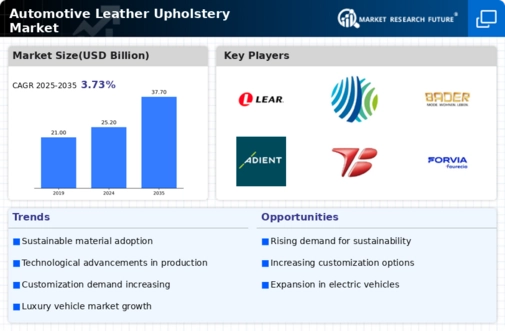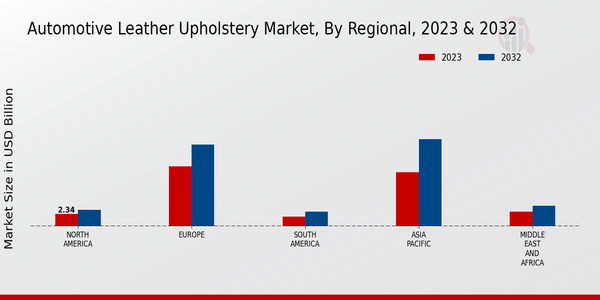Market Growth Chart
The Global Automotive Leather Upholstery Market Industry is projected to exhibit a steady growth trajectory, with a market size of 25.2 USD Billion in 2024 and an anticipated increase to 37.7 USD Billion by 2035. The compound annual growth rate (CAGR) for the period from 2025 to 2035 is estimated at 3.73%, indicating a consistent demand for leather upholstery in the automotive sector. This growth is driven by various factors, including rising consumer preferences for luxury vehicles, advancements in leather production technologies, and the increasing popularity of electric vehicles.
Growth of Electric Vehicles
The rise of electric vehicles (EVs) is poised to impact the Global Automotive Leather Upholstery Market Industry positively. As the automotive sector transitions towards electrification, manufacturers are increasingly focusing on interior quality to differentiate their products. Leather upholstery is often perceived as a premium feature, enhancing the overall appeal of EVs. With projections indicating that the market will grow to 37.7 USD Billion by 2035, the integration of leather in EV interiors is likely to become a standard practice. This trend underscores the importance of high-quality materials in attracting environmentally conscious consumers who seek luxury in their driving experience.
Rising Consumer Demand for Luxury Vehicles
The Global Automotive Leather Upholstery Market Industry is experiencing a notable surge in consumer demand for luxury vehicles, which often feature high-quality leather interiors. This trend is driven by an increasing preference for premium materials that enhance the aesthetic appeal and comfort of vehicles. As consumers become more discerning, manufacturers are compelled to incorporate leather upholstery to meet these expectations. In 2024, the market is projected to reach 25.2 USD Billion, reflecting the growing inclination towards luxury and comfort in automotive design. This demand is likely to persist, contributing to the overall growth of the industry.
Regulatory Support for Sustainable Practices
Regulatory frameworks promoting sustainable practices are influencing the Global Automotive Leather Upholstery Market Industry. Governments worldwide are implementing stricter environmental regulations, encouraging manufacturers to adopt eco-friendly materials and processes. This shift towards sustainability is prompting automotive companies to explore alternative leather options, such as synthetic or plant-based leathers, which can meet regulatory standards while appealing to environmentally conscious consumers. As the market adapts to these changes, the demand for sustainable leather upholstery is likely to grow, aligning with broader industry trends towards responsible manufacturing and consumption.
Increasing Disposable Income in Emerging Markets
The Global Automotive Leather Upholstery Market Industry is benefiting from rising disposable incomes in emerging markets. As economic conditions improve, consumers in these regions are more inclined to invest in vehicles that offer enhanced comfort and luxury features, including leather upholstery. This trend is particularly evident in countries such as India and Brazil, where the automotive sector is expanding rapidly. The increased purchasing power allows consumers to opt for higher-end models, thereby driving demand for leather interiors. This shift is expected to sustain the market's growth, as more consumers seek to elevate their driving experience through premium materials.
Technological Advancements in Leather Production
Technological innovations in leather production are significantly influencing the Global Automotive Leather Upholstery Market Industry. Advances in tanning processes, such as chrome-free tanning and eco-friendly treatments, are enhancing the quality and sustainability of automotive leather. These innovations not only improve the durability and appearance of leather but also align with the increasing consumer demand for environmentally responsible products. As manufacturers adopt these technologies, they can offer superior leather options that appeal to a broader audience. This shift is expected to support the market's growth trajectory, particularly as sustainability becomes a key consideration for consumers.





















